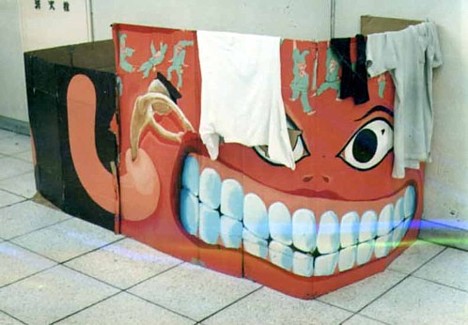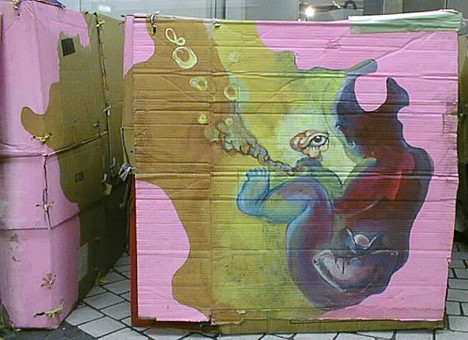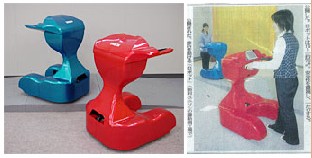 Nomura Unison Co., Ltd. has developed a walking-assistance robot that perceives and responds to its environment. The machine, called Walking Partner Robot, was developed with the cooperation of researchers from Tohoku University. It will be unveiled to the general public at the 2006 Suwa Area Industrial Messe on October 19 in Suwa, Nagano prefecture.
Nomura Unison Co., Ltd. has developed a walking-assistance robot that perceives and responds to its environment. The machine, called Walking Partner Robot, was developed with the cooperation of researchers from Tohoku University. It will be unveiled to the general public at the 2006 Suwa Area Industrial Messe on October 19 in Suwa, Nagano prefecture.
The robot is equipped with a system of sensors that detect the presence of obstacles, stairs, etc. while monitoring the motion and behavior of the user. Three sensors monitor the status of the user while detecting and measuring the distance to potential obstacles, and two angle sensors measure the slope of the path in front of the machine. The robot responds to these measurements with voice warnings and by automatically applying brakes when necessary.
Walking Partner Robot is essentially a high-tech walker designed to support users as they walk upright, preventing them from falling over. The user grasps a set of handles while pushing the unmotorized 4-wheeled robot, which measures 110 (H) x 70 (W) x 80 (D) cm and weighs 70 kilograms (154 lbs).
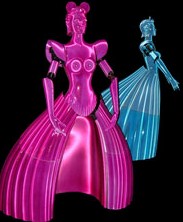 Walking Partner Robot is the second creation from the team responsible for the Partner Ballroom Dance Robot, which includes Tohoku University robotics researchers Kazuhiro Kosuge and Yasuhisa Hirata. The goal was to apply the Partner Ballroom Dance Robot technology, which perceives the intended movement and force of human footsteps, to a robot that can play a role in the realm of daily life. The result is a machine that can perceive its surroundings and provide walking assistance to the elderly and physically disabled.
Walking Partner Robot is the second creation from the team responsible for the Partner Ballroom Dance Robot, which includes Tohoku University robotics researchers Kazuhiro Kosuge and Yasuhisa Hirata. The goal was to apply the Partner Ballroom Dance Robot technology, which perceives the intended movement and force of human footsteps, to a robot that can play a role in the realm of daily life. The result is a machine that can perceive its surroundings and provide walking assistance to the elderly and physically disabled.
The developers, who also see potential medical rehabilitation applications, aim to develop indoor and outdoor models of the robot. The company hopes to make the robot commercially available soon at a price of less than 500,000 yen (US$4,200) per unit.
[Source: Nagano Nippo]
 As part of an ongoing battle against invading swarms of giant jellyfish in local waters, some residents of Fukui prefecture have developed a method for converting the sea creatures into a powdered ingredient used in souvenir cookies.
As part of an ongoing battle against invading swarms of giant jellyfish in local waters, some residents of Fukui prefecture have developed a method for converting the sea creatures into a powdered ingredient used in souvenir cookies. 
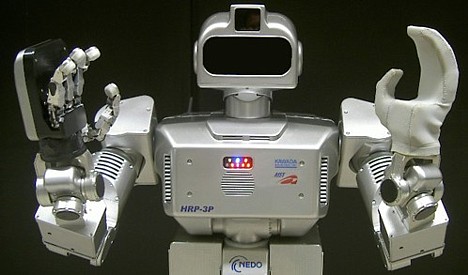
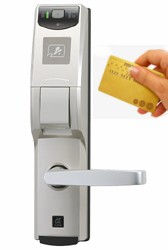 A new project to develop "unmanned hotels" in Japan may soon eliminate the burdensome task of checking in at the front desk. A consortium of five companies, including the trading company
A new project to develop "unmanned hotels" in Japan may soon eliminate the burdensome task of checking in at the front desk. A consortium of five companies, including the trading company 
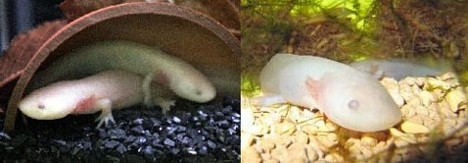
 On October 19, East Japan Railway Company (JR East) made a test run of its
On October 19, East Japan Railway Company (JR East) made a test run of its 
 Walking Partner Robot is the second creation from the team responsible for the Partner Ballroom Dance Robot, which includes Tohoku University robotics researchers Kazuhiro Kosuge and Yasuhisa Hirata. The goal was to apply the Partner Ballroom Dance Robot technology, which perceives the intended movement and force of human footsteps, to a robot that can play a role in the realm of daily life. The result is a machine that can perceive its surroundings and provide walking assistance to the elderly and physically disabled.
Walking Partner Robot is the second creation from the team responsible for the Partner Ballroom Dance Robot, which includes Tohoku University robotics researchers Kazuhiro Kosuge and Yasuhisa Hirata. The goal was to apply the Partner Ballroom Dance Robot technology, which perceives the intended movement and force of human footsteps, to a robot that can play a role in the realm of daily life. The result is a machine that can perceive its surroundings and provide walking assistance to the elderly and physically disabled. 


